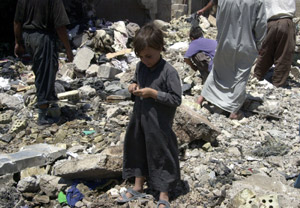| Home | Blog | Ask This | Showcase | Commentary | Comments | About Us | Contributors | Contact Us |

Ask our military leaders what our troops are doing to avoid killing civiliansASK THIS | August 225, 2004Harvard security expert Sarah Sewall thinks reporters should be asking the Pentagon and Congress what they are learning in Iraq about minimizing civilian casualties - and how well they are doing. By Sarah Sewall Q. President Bush said the U.S. would do everything possible to avoid civilian casualties in Iraq. How does the Pentagon assess its effectiveness regarding that claim? From what baseline is that assessment reached? Q. Does the Pentagon study the effects of its operations upon civilians? If not, how does it know it has done everything possible to avoid civilian harm? Q. Could you summarize the key operational lessons learned -- during Operation Iraqi Freedom (OIF) or since the end of major combat operations -- regarding how U.S. forces can mitigate civilian casualties? Who is responsible for evaluating military operations in order to improve U.S. performance in this key area? Q. Since OIF began, what adjustments have U.S. forces made in their training or tactics reflecting lessons from incidents in which civilians have died? Have these changes made a difference? How is the impact measured? While the U.S. carefully investigates and accounts for Americans killed in Iraq, it has no official record of Iraqi combatant or non-combatant deaths. Military resistance to the notion of an enemy “body count” stems from Vietnam, where the metric proved both meaningless and misleading. Since that time, U.S. and international publics have become increasingly interested in the number of civilian casualties as a means of assessing the cost of war. Pentagon officials explain that they do not track Iraqi civilian casualties because it is difficult and is not their responsibility. It is hard to say what might be considered a reliable estimate of civilian casualties.
A team of Associated Press reporters tried to determine the civilian death toll early in the war, from March 20 to April 20, 2003. Their count, which they considered fragmentary: At least 3,240 Iraqi civilians killed. The Web site IraqBodyCount.org compiles media report on civilian deaths. As of this writing, their estimate ranges from a low of 11,487 to a high of 13,458. Aljazeera.net recently reported on an Iraqi group that claimed some 37,000 total. While most experts considered such a number grossly exaggerated, no reliable and comprehensive data is available. The numbers themselves tell us relatively little. They do not explain how a civilian died. Faulty intelligence? A guidance system malfunction? Abuse as a human shield? Nor do the numbers tell us whether or how the U.S. might reasonably have been able to reduce civilian casualties. This, ultimately, is the information U.S. forces need. Numbers can be one halting step toward getting us there. U.S. leaders appear fearful of what the numbers might tell us. But if they won’t even ask the questions, the military can’t improve its efforts to minimize civilian harm.
|




